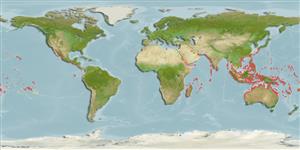>
Centrarchiformes (Basses) >
Kuhliidae (Aholeholes)
Etymology: Kuhlia: Because of Heindrich Kuhl, 1797-1821; researcher also with lizards (Gekkonidae).
More on author: Forster.
Environment: milieu / climate zone / depth range / distribution range
Ecología
marino; salobre asociado a arrecife; rango de profundidad 3 - 18 m (Ref. 5227). Tropical; 32°N - 32°S
Indo-Pacific and Eastern Pacific: Red Sea and East Africa to the eastern Pacific, north to southern Japan, south to New South Wales and Lord Howe Island. Absent from Easter Island, Pitcairn, Marquesas, Hawaiian Islands and Johnston Island.
Tamaño / Peso / Age
Maturity: Lm ? range ? - ? cm
Max length : 40.0 cm SL macho / no sexado; (Ref. 4967); common length : 20.0 cm TL macho / no sexado; (Ref. 30573)
Espinas dorsales (total): 10; Radios blandos dorsales (total): 10-11; Espinas anales 3; Radios blandos anales: 10 - 12. Preorbital serrae 11-14; body depth 2.75-3.05 in SL; caudal concavity 1.85-2.6 in head length; Silvery, the front of snout and chin blackish; caudal fin white with a median dark stripe and two broad oblique black bands across each lobe, the lobe tips white; a dusky band in outer part of soft portion of dorsal fin except for white tip of high anterior part. Juveniles (2.0-3.0 cm SL) have the median and outer black bands in the caudal fin lobes, but the middle band is represented only by a black spot basally in the outer part of each lobe (Ref. 41640).
Tightly packed schools occur along the reef margin of rocky shorelines, from just below the breaking surf to a depth of a few meters. Young commonly in tide pools (Ref. 41640). Sometimes found in estuaries but reported to never enter freshwater environments (Ref. 41640). Feeds on free-swimming crustaceans and small fishes at night (Ref. 5213). Utilized fresh or dried salted (Ref. 7271).
Life cycle and mating behavior
Madurez | Reproducción | Puesta | Huevos | Fecundidad | Larva
Randall, J.E. and H.A. Randall, 2001. Review of the fishes of the genus Kuhlia (Perciformes: Kuhliidae) of the Central Pacific. Pac. Sci. 55(3):227-256. (Ref. 41640)
IUCN Red List Status (Ref. 130435)
Threat to humans
Harmless
Human uses
Pesquerías: escaso valor comercial; Acuario: Acuarios públicos; carnada: usually
Más información
ReferenciasAcuiculturaPerfil de acuiculturaRazasGenéticaElectrophoresesheritabilidadEnfermedadesProcesamientoNutrientsMass conversion
Herramientas
Special reports
Download XML
Fuentes de Internet
Estimates based on models
Preferred temperature (Ref.
123201): 24.5 - 29.3, mean 28.3 °C (based on 3387 cells).
Phylogenetic diversity index (Ref.
82804): PD
50 = 0.5002 [Uniqueness, from 0.5 = low to 2.0 = high].
Bayesian length-weight: a=0.01413 (0.00591 - 0.03375), b=3.06 (2.86 - 3.26), in cm total length, based on LWR estimates for this (Sub)family-body shape (Ref.
93245).
Nivel trófico (Ref.
69278): 3.8 ±0.60 se; based on food items.
Resiliencia (Ref.
120179): Bajo, población duplicada en un tiempo mínimo de 4.5-14 años (Preliminary K or Fecundity.).
Fishing Vulnerability (Ref.
59153): Moderate vulnerability (39 of 100).
Nutrients (Ref.
124155): Calcium = 44 [26, 71] mg/100g; Iron = 0.575 [0.354, 0.901] mg/100g; Protein = 19.3 [18.2, 20.2] %; Omega3 = 0.133 [0.085, 0.208] g/100g; Selenium = 22.8 [12.7, 39.6] μg/100g; VitaminA = 151 [50, 462] μg/100g; Zinc = 1.33 [0.94, 1.83] mg/100g (wet weight);
